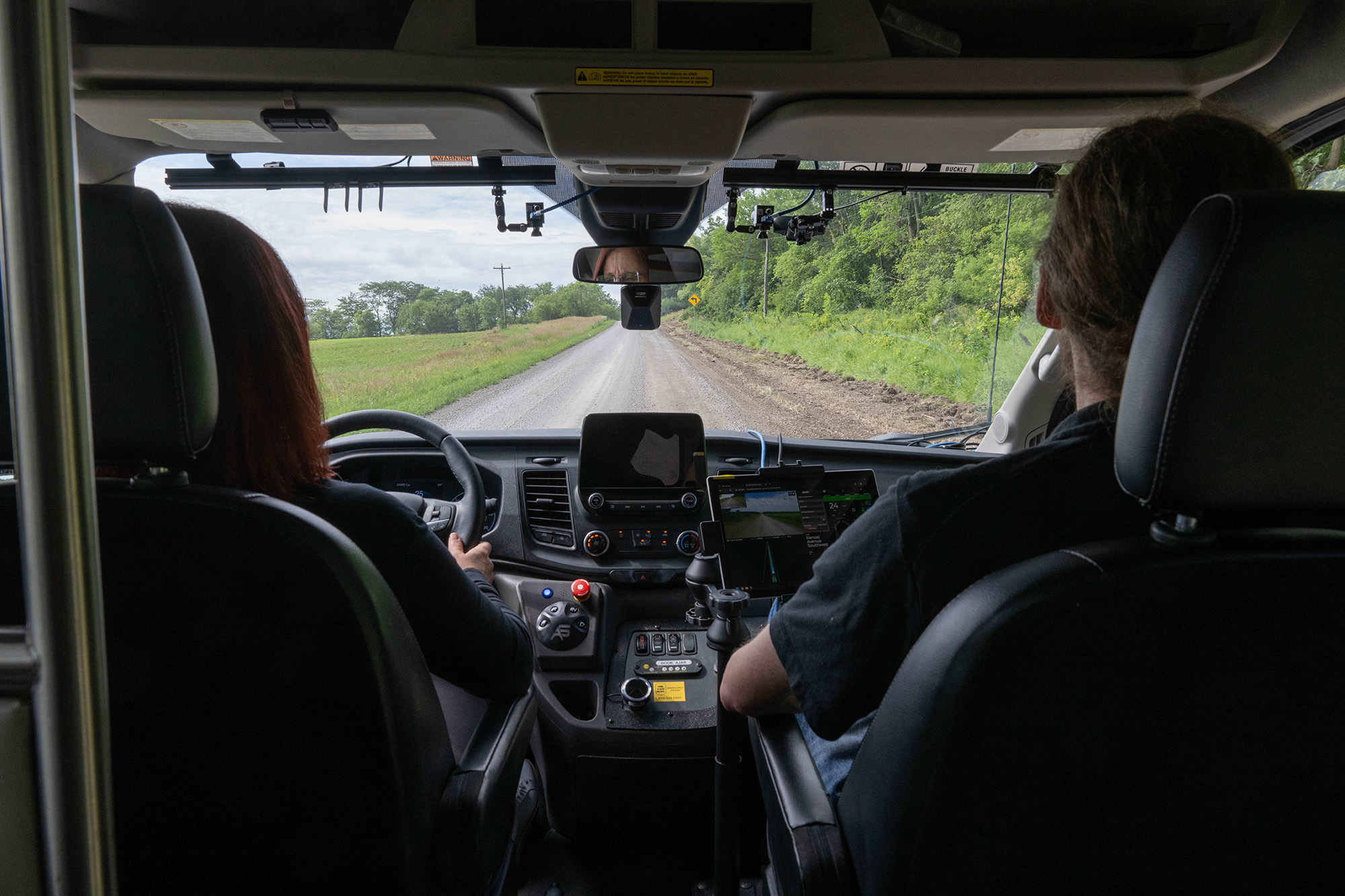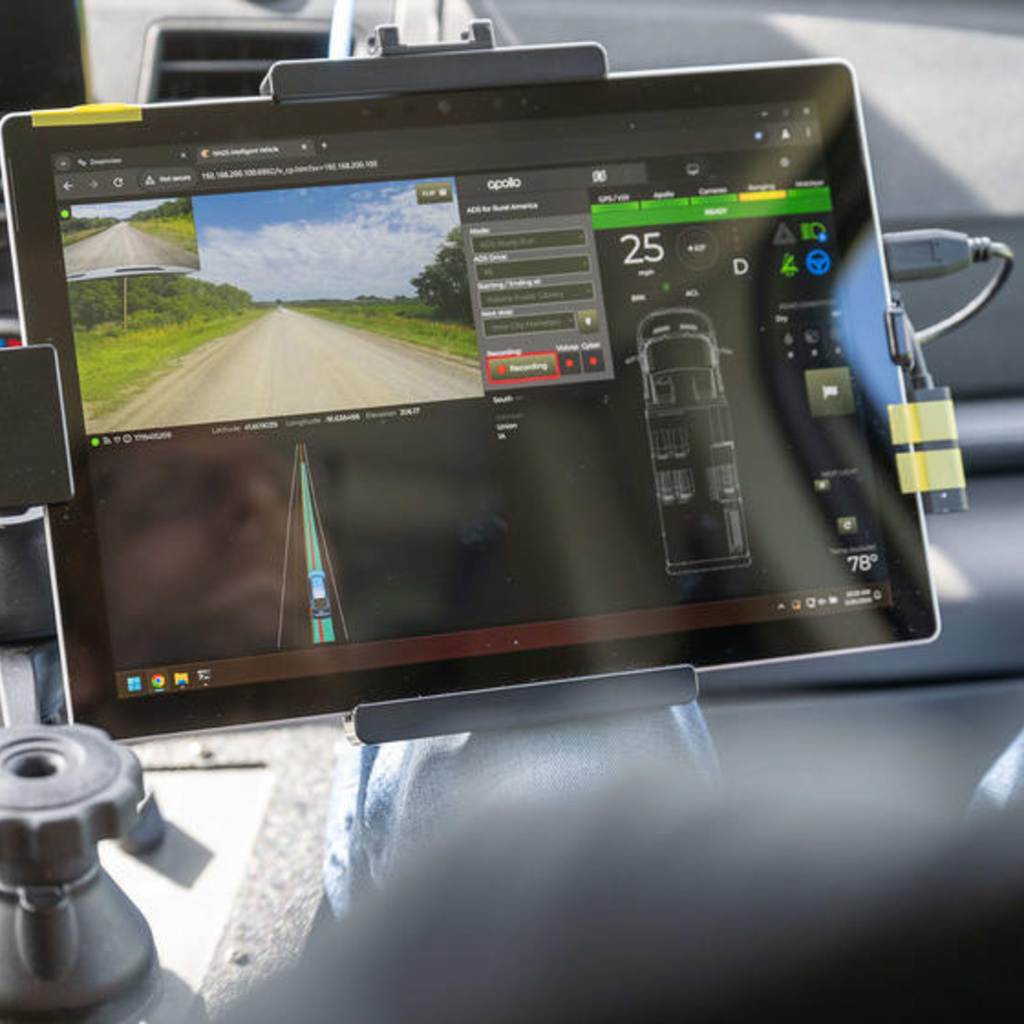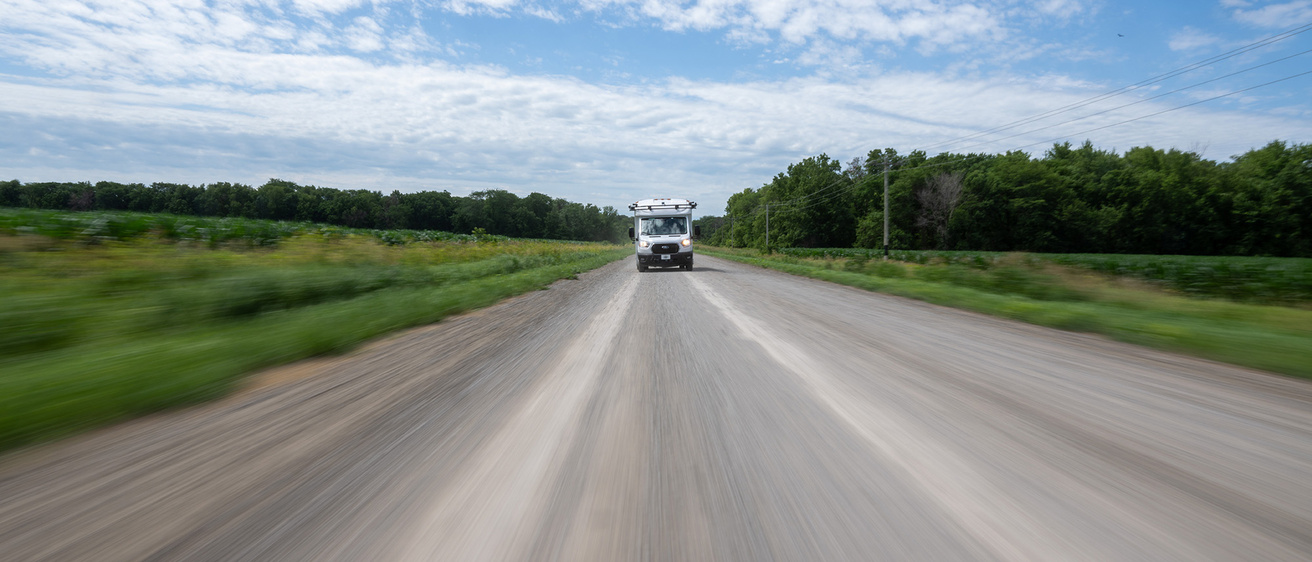Researchers at the Driving Safety Research Institute at the University of Iowa have completed more than three years of testing to learn the challenges automated vehicles encounter when operating on rural roads.
Story: Richard C. Lewis
Photography: Justin Torner
Videography: David Scrivner and Clarity Guerra
Published: Oct. 14, 2024
As a shuttle van cruised down a gravel road south of Iowa City, Cheryl Roe had a serene look on her face, even though she, as the driver, was not grasping the steering wheel.
“I really have to become one with the vehicle,” Roe says. “I have to know what it’s going to do and when it’s going to do it.”
Far from some mystical automotive kinship, Roe’s ease comes from knowing the vehicle had been trained to drive on that road. Roe, the automated vehicle transportation outreach specialist at the Driving Safety Research Institute (DRSI) at the University of Iowa, operates the shuttle as part of a federally funded pilot program to study how automated vehicles can run safely on rural roads. While automated rural driving is far from a reality, researchers envision a day when Iowans and other rural residents have another safe transportation option to make a doctor’s appointment or grocery store run.
“We’ve chosen to own our ruralness,” says Daniel McGehee, director of the DSRI, which was the first in the nation to study automated driving in rural conditions. “We want to look at increasing people’s quality of life through adding another dimension of transportation that’s not available today, that will allow rural folks to extend their lives in a social and healthy way.”
With more than three decades of expertise in vehicle-human safety, DSRI leads the Automated Driving Systems (ADS) for Rural America Demonstration project, which in December 2023 wrapped up three and a half years of research to understand the unique demands that rural roads place on automated vehicles. DSRI researchers confronted myriad obstacles: the sheer variety of rural driving environments; the effects of snow, sleet, and other weather variables; and the need for technological innovations to navigate rural roads.
“Our goal was to highlight the challenges and opportunities of operating an automated transit vehicle on rural roadways and to share that knowledge with everybody, such as the government, industry, and other stakeholders,” says Omar Ahmad, project manager for ADS for Rural America. “We wanted to raise questions: ‘Hey, have you thought about what’s going to happen when you operate in a four-season state like Iowa that has all sorts of weather?’”
“We’ve chosen to own our ruralness. We want to look at increasing people’s quality of life through adding another dimension of transportation that’s not available today, that will allow rural folks to extend their lives in a social and healthy way.”
Driverless vehicles currently operating in the U.S. are mostly confined to large cities, where roads are well marked and precisely mapped, and to areas of the nation that do not experience major seasonal changes. Expanding automated driving to rural areas, with their open spaces, inclement weather, and diversity of roads and driving conditions, requires a different approach. But it is important: While one-fifth of Americans live in rural areas, nearly half of traffic fatalities occur on rural roads, according to a report from the Governors Highway Safety Association.
Unincorporated areas come with a cacophony of motoring challenges: roads that are unpaved, roads that have no lane markings, roads with no shoulders, roads that suddenly veer at abrupt angles, roads where the speeds drop abruptly from highway to town limits, and roads dotted with intersections lacking any directional signs. Heck, in Iowa, there’s even a gravel intersection with a tree in the middle. (Look it up: It’s in Audubon County.)
Ahmad and his team welcomed these challenges when they won the research award from the U.S. Department of Transportation. The researchers plotted a 47-mile fixed route with stops in three small towns — Hills, Kalona, and Riverside — and one urban area, Iowa City. The shuttle picked up passengers at each stop, who rated their anxiety levels on a tablet while riding. The ADS for Rural America vehicle drove in all seasons, on different days, during peak and off-peak time periods, and at speeds that ranged from in-town limits to highway posted limits of 65 mph.
“We chose a route to be as representative as possible of the different types of roadways that you may see in rural areas,” Ahmad says.

Cheryl Roe, the automated vehicle transportation outreach specialist at the Driving Safety Research Institute (DRSI) at the University of Iowa, and data management lead Stephen Cable conduct research in an automated vehicle on one of Iowa’s rural roads. One major challenge for the researchers: “teaching” the vehicle how to operate safely on gravel roads.
The ADS for Rural America shuttle encountered oncoming vehicles, vehicles changing lanes around it, stop-and-go traffic, pedestrians, bicyclists, and even horse-driven buggies. Roe, as the driver, determined when to put the vehicle in automated mode, while Stephen Cable, the data management lead seated beside Roe, monitored the shuttle’s performance in real time via GPS and an array of LiDAR and radar sensors that mapped the terrain and spotted any navigational obstacles.
Almost immediately from the start of the project, the team noticed the automated system had trouble responding adeptly to vehicles slowing in front of it. It also interpreted the posted speed limit as a mandate to reach that speed as quickly as possible, resulting in sudden bursts of acceleration. Meanwhile, the shuttle’s exterior sensors were prone to fogging or icing, which in essence could blind the vehicle when in automated mode. The researchers also learned that neither LiDAR, which maps in close range, nor radar, which senses longer range, would suffice independently. The DSRI team combined the systems to render a fuller-distance field of vision for the shuttle.
Arguably the biggest challenge was “teaching” the vehicle how to operate safely on gravel roads. At nearly 1.4 million miles, unpaved roads are ubiquitous in rural America, accounting for about 35% of the nation’s roadways. Yet driving on them is a learned experience; with typically no center line and angled, rock-strewn edges, drivers are accustomed to sticking to the center and then easing to the right for an oncoming vehicle.
All of this was new, fertile territory for DSRI researchers.
“A very important finding is that automated vehicles need to adapt their behavior to being on a gravel road,” Ahmad says. “They need to recognize that they’re on a gravel road, and then they need to adapt their behavior to more closely mimic how human beings drive gravel roadways.”

Driving Safety Research Institute
The research at the DSRI saves lives, improves quality of life for drivers, advances driving simulation technologies, and improves the efficiency and productivity of the automotive and supporting industries.
The DSRI detailed its findings last November in a 101-page report currently under review by the Department of Transportation. Researchers have applied for additional funding from the DOT to continue their studies.
“We are very excited; we’re encouraged,” Ahmad says. “The technology shows a lot of promise, and I think with more testing, it will get better, and we will see solutions that work for everybody.”
